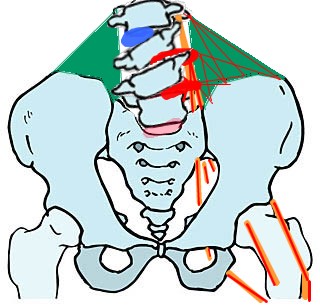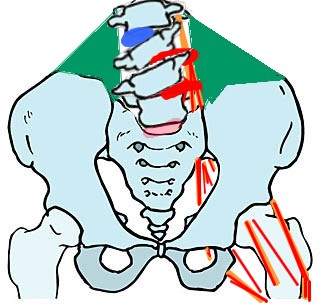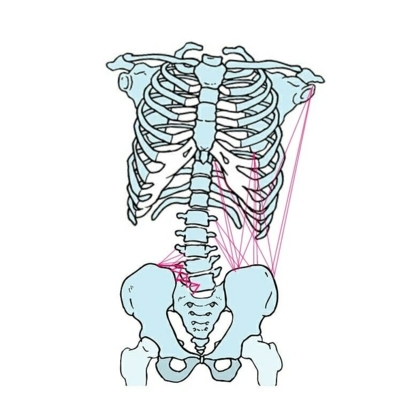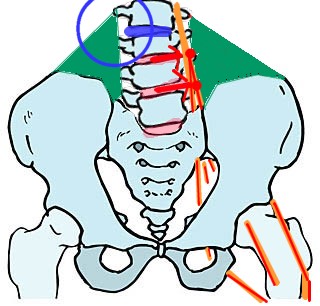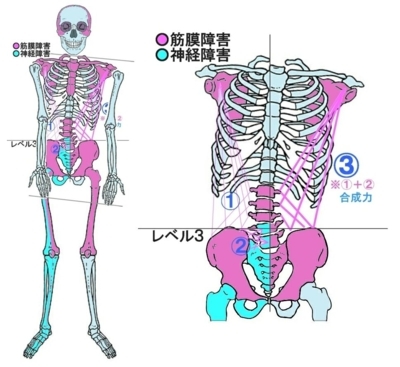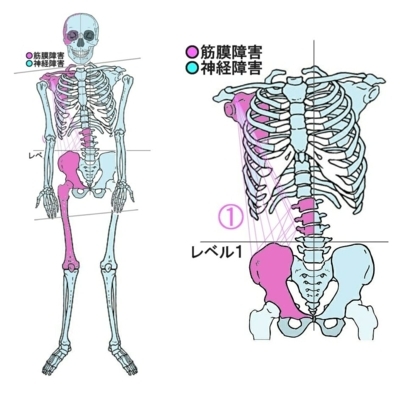カイロプラクティックについて:厚労省の補完統合医療推進事業で公開されている現在改善された公開中の資料は良い翻訳だと思います。当院では恣意的な翻訳と受け止め初期公開より後退が見られたため、以下は参考のために英文を当院が原文に対して独自に翻訳していたものです。
カイロプラクティック部門
- アメリカ合衆国・国立補完統合衛生センター
カイロプラクティックは身体の構造体(主眼は脊椎)と生体作用の間における関係に注目した健康ケア業種です。治療師は様々な効果の違った施術法を用いることで、中核をなす手技調整を使い、目的とする問題のあるアライメントの脊椎または身体の部位へ修正を実行し、痛みの緩和、生体作用の改善、加えて体の自然治癒力による自己回復をサポートするものです。 -
キーポイント
*カイロプラクティックのほとんどの研究は脊椎調整手技に焦点を当てたものです。この脊椎調整手技は多くの人の腰痛に恩恵(大きな貢献)を表し、頭痛や頸部痛、上肢・下肢の関節障害、むち打ち・頸椎の不整合配列の助けにもなります。
*脊椎調整手技の副作用として一時的な「頭痛・疲労感・施術した身体部位の不快感」を含めることができます。ただし、重篤な副作用が脊椎調整手技によるものかは実際には不明といえますが、ごく稀な報告として脳出血のような重い弊害症状があることも覚えておく必要はあります。安全性は重要な関心として現在も進行中の調査にとどめ置かれています。
*ご自身が掛かりつけや掛かろうとする医療者に、ご自身のおこなっている「少なからずも賞賛したいと思う方法論があること(自分には良いと感じてやっていることすべて)」について知らせてください。そうすれば、すべてのご自身の健康管理ですべきことを完全に把握することができます。医療者との情報共有により、確実に調和した安全な治療が保証されるといえます。 -
概要と歴史
「カイロプラクティック」という用語は、ギリシャ語のカイロ(手)とプラクティス(技量)を手による治療法という意味に描写した合成語です。手による治療(特に脊椎の調整手技)がカイロプラクティック治療の中核といえます。カイロプラクティックは身体の構造体(第一義的には脊椎)と身体の構造体が健康に影響を及ぼす生体作用(神経作用システムよって調和をとるとする)における「相互的な関連性の観念」に基づくといえるでしょう。脊椎調整手技「マニピュレーション」はカイロプラクティック治療の核心をなす施術法といえますが、脊椎調整手技をしてカイロプラクティック治療の同義ということにはできません。カイロプラクティック師は脊椎調整手技に加えて他の施術法もまた併用をし、そして他の医療提供者(理学療法士や数種の姿勢骨格を扱う治療師)においてもまた同様に脊椎調整手技が使われもします
アメリカ合衆国での利用状況
アメリカ合衆国においてカイロプラクティックはたびたび補完医療として考慮する治療法の対象とされています。包括的なアメリカ国籍を持つ人による補完医療の使用状況調査を含む【2007年度アメリカ合衆国国民健康調査(NHIS)】に従うと、昨年の1年間に成人の約8%(ほぼ1800万人)と子供では3%近い(ほぼ200万人)がカイロプラクティックや姿勢骨格手技療法を受けていたことがわかっています。
追記事項として、【国民健康調査(NHIS)の経費調査資料】の解析結果で、合衆国の成人が費やすおおよそ119億ドルのうち、カイロプラクティックやその他の姿勢骨格手技を受けるためにそれらの事業所に対して39億ドルが費やされていることがわかりました。
カイロプラクティック治療を受けようとする大部分の人が腰痛です。また少なからずの人が同様に筋骨格系(頸部痛、肩関節痛など)の疼痛や頭痛、四肢の障害(手や足など)のために受けています。
【2002年度の調査資料における腰痛のための補完医療の利用の分析】では、抜きんでてカイロプラクティックが最も一般的に利用されてていたことが分かりました。この調査対象者の皆さんが腰痛のために用いた様々な治療のなかで、カイロプラクティックが74%(概算で400万人のアメリカ人)に利用されており、そして、このカイロプラクティックを腰背部痛へ用いた調査対象者の皆さんのうち、治療により66%(概算で264万人)の人が「素晴らしい改善」が得られたと認識しています。-
治療法
初回時にはカイロプラクティック師は典型的に病歴問診と特に脊椎を重用項目とした体の触診検査を実行します。典型的とはいえませんが、他の検査診断法に例えばレントゲン撮影のような検査も行われることがあります。カイロプラクティック治療に適合すると判断された場合、以降への治療法や施術法の考察が立てられることになります。
次回からの本格的な治療開始では施術者はカイロプラクティック師が持つ多種多様な脊椎調整術や他の概念の治療手技の中から一つもしくは二つ以上の異なった施術を治療実行します。
カイロプラクティックの調整は主となる脊椎調整は手技だけでなく、手技以外の急速な脊椎や関節への物理エネルギーを管理調整する装置を用いる場合も含まれます。治療は治療部位の動作の範囲や神経作用がもたらす特性を拡大し、速やかな健康の回復を促進するために集約的に行われる治療です。異なった観念で行われる他の手技療法の技術である関節可動性回復術も使用されています。カイロプラクティック師は脊椎調整手技に加えて他の数種の手技療法技術と以下に列挙の施術を複合させて総合的におこなわれるものです。
温熱もしくは冷却療法
経皮電気刺激療法
筋肉弛緩テクニック
回復促進作用の動作訓練(リハビリ訓練)
生活習慣病や減量などの食事療法の相談
食事療法の補助食品
-
科学的な検証
調査は背部痛、頸部痛、喘息による肩の痛み、手根管症候群、筋繊維症、そして頭痛について様々な状態に対しての脊椎調整手技による対象検証を試みました。腰痛に焦点を合わせて行われた調査では、脊椎調整手技で多くの人の腰痛の症状の改善を明確に表し大変重要な検証結果となりました(より多くの情報は腰痛における脊椎調整手技資料を参照)。
2010年には、手技療法の適応症とした科学的根拠と題した報告書は、追加事項として脊椎調整手技(関節可動法を含む)は背部痛、偏頭痛、肩首のコリ(頸部に関係した)の頭痛、頸部痛、上肢下肢の関節症、頸椎配列不良のむち打ち症というかなりの種類の症状に有効であると結論付けることになっています。
また加えてこの論評では、脊椎調整手技(関節可動法を含む)が(喘息、高血圧、生理痛)に有効であるとまでは言えないとし、科学的根拠がいまだ不十分である例として(筋繊維症、背中の疼痛、月経前症候群、坐骨神経痛、顎関節症)といった症状もあるとの認識を報告しています。
安全性
開業:学位と資格
カイロプラクティック学術審議会(CCE)によって認定されたカイロプラクティック単科大学によって、カイロプラクティック医師(D.C.)学位の取得課程が実施されています(※カイロプラクティック学術審議会(CCE)はアメリカ合衆国内のカイロプラクティック単科大学の認定を行うアメリカ教育省の政府機関です)。カイロプラクティック単科大学への入学は、大方の場合は科学系単位としますが大学での最低90単位の単位取得が必要となります。カイロプラクティック課程は4年制の専門技能課程で、講義と患者に対する治療実習があります。典型的な教育課程は公衆衛生や検査法だけでなく生物医科学全般です。多くのカイロプラクティック師は専門分野の研修のために2~3年の医療実習期間を希望し研修をしています。
カイロプラクティックはワシントンDCと各州により、各々正式の基準を設けています。すべての州でカイロプラクティック学術審議会(CCE)認定のカイロプラクティックドクター学位課程の終了を義務付けています。試験は免許要項と模擬治療実技が義務付けられ国立カイロプラクティック試験会によって施行されるものです。
ほとんどの州では一年ごとにカイロプラクティック師に免許の更新に継続講習の履修を義務付けています。カイロプラクティック師の業務範囲は州よって違いがあり、健康補助食品の取り扱いや、鍼治療、ホメオパシー(同毒療法)など他の補完医療を使える使えないなど地域によって様々です。
-
カイロプラクティックの受診するを検討している方へ
カイロプラクティック師の学位と免許をご確認ください。
カイロプラクティック師にあなたの病歴などをお知らせください。そのうえで、お尋ねの症状へ対応した技術と経験を持っているかご確認ください。
各種保険の利用や主な支払い方法についてご確認ください。(カイロプラクティックは多くの健康管理機関の補助や個人医療保険、健康保険などで保障が受けることができます。)
薬を使っている場合は(処方もしくは自分で薬店で購入の薬)や健康食品サプリメントについて、カイロプラクティック師にご相談ください。もしカイロプラクティック師に健康補助食品を推薦された場合には、ご利用中の薬や他のサプリメントとの潜在的な相互影響をお尋ねください。ご利用中の補完医療がある場合は、そのことについてご利用になっているすべての医療提供者にお知らせください。
このようにすることで、すべてのご自身の健康管理ですべきことを完全に把握することができます。医療者との情報共有により、確実に調和した安全な治療が保証されるといえます。 -
アメリカ合衆国・国立補完統合衛生センターの支援している調査報告
アメリカ合衆国・国立補完統合衛生センターのカイロプラクティック治療における支援調査は以下の項目に視点を合わせて行われています。
1:腰痛、頸部痛、頭痛の他に顎関節症などの症状における脊椎調整手技の効果
2:カイロプラクティック教育制度において、医学根拠を伴った治療を行おうということへの理解を含む教育制度を発展させること
3:腰痛患者に対してカイロプラクティックと現代医学でグループ分けして腰痛治療した結果の様子を比較する課題で、患者の治療満足度(症状改善)にはどのような違いがあるのかの研究
このほかアメリカ合衆国・国立補完統合衛生センターはパーマー大学カイロプラクティック研究所の中にカイロプラクティック開発調査基金の助成を行っています。パーマー大学やその他の関係研究機関による調査団がカイロプラクティック治療における基礎医学調査に加えて臨床調査の運営指揮を執っており、彼らの献身的な働きできっと様々な障害や症候への最も有効な方法が結実していくことでしょう。
Chiropractic: In Depth
NCCIH
Chiropractic is a health care profession that focuses on the relationship between the body's structure-mainly the spine-and its functioning.
Although practitioners may use a variety of treatment approaches,
they primarily perform adjustments (manipulations) to the spine or other parts of the body with the goal of correcting alignment problems,
alleviating pain,
improving function,
and supporting the body's natural ability to heal itself.
Key Points
*Most research on chiropractic has focused on spinal manipulation.
Spinal manipulation appears to benefit some people with low-back pain and may also be helpful for headaches,
neck pain,
upper- and lower-extremity joint conditions,
and whiplash-associated disorders.
*Side effects from spinal manipulation can include temporary headaches,
tiredness,
or discomfort in the parts of the body that were treated.
There have been rare reports of serious complications such as stroke,
but whether spinal manipulation actually causes these complications is unclear.
Safety remains an important focus of ongoing research.
*Tell all your health care providers about any complementary health approaches you use.
Give them a full picture of what you do to manage your health.
This will help ensure coordinated and safe care.
Overview and History
The term “chiropractic” combines the Greek words cheir (hand) and praxis (practice) to describe a treatment done by hand.
Hands-on therapy-especially adjustment of the spine-is central to chiropractic care.
Chiropractic is based on the notion that the relationship between the body’s structure (primarily that of the spine) and its function (as coordinated by the nervous system) affects health.
Spinal adjustment/manipulation is a core treatment in chiropractic care,
but it is not synonymous with chiropractic.
Chiropractors commonly use other treatments in addition to spinal manipulation,
and other health care providers (e.g., physical therapists or some osteopathic physicians) may use spinal manipulation.
Use in the United States
In the United States,
chiropractic is often considered a complementary health approach.
According to the 2007 National Health Interview Survey (NHIS),
which included a comprehensive survey of the use of complementary health approaches by Americans,
about 8 percent of adults (more than 18 million) and nearly 3 percent of children (more than 2 million) had received chiropractic or osteopathic manipulation in the past 12 months.
Additionally,
an analysis of NHIS cost data found that adults in the United States spent approximately $11.9 billion out-of-pocket on visits to complementary health practitioners-$3.9 billion of which was spent on visits to practitioners for chiropractic or osteopathic manipulation.
Many people who seek chiropractic care have low-back pain.
People also commonly seek chiropractic care for other kinds of musculoskeletal pain (e.g., neck, shoulder),
headaches,
and extremity (e.g., hand or foot) problems.
An analysis of the use of complementary health approaches for back pain,
based on data from the 2002 NHIS,
found that chiropractic was by far the most commonly used therapy.
Among survey respondents who had used any of these therapies for their back pain,
74 percent (approximately 4 million Americans) had used chiropractic.
66 percent perceived “great benefit” from their treatments.
Treatment
During the initial visit,
chiropractors typically take a health history and perform a physical examination,
with a special emphasis on the spine.
Other examinations or tests such as x-rays may also be performed.
If chiropractic treatment is considered appropriate,
a treatment plan will be developed.
During followup visits,
practitioners may perform one or more of the many different types of adjustments and other manual therapies used in chiropractic care.
Given mainly to the spine,
a chiropractic adjustment involves using the hands or a device to apply a controlled,
rapid force to a joint.
The goal is to increase the range and quality of motion in the area being treated and to aid in restoring health.
Joint mobilization is another type of manual therapy that may be used.
Chiropractors may combine the use of spinal adjustments and other manual therapies with several other treatments and approaches such as:
*Heat and ice
*Electrical stimulation
*Relaxation techniques
*Rehabilitative and general exercise
*Counseling about diet, weight loss, and other lifestyle factors
*Dietary supplements.
What the Science Says
Researchers have studied spinal manipulation for a number of conditions ranging from back,
neck,
and shoulder pain to asthma,
carpal tunnel syndrome,
fibromyalgia,
and headaches.
Much of the research has focused on low-back pain,
and has shown that spinal manipulation appears to benefit some people with this condition.
(For more information, see the Spinal Manipulation for Low-Back Pain fact sheet.)
A 2010 review of scientific evidence on manual therapies for a range of conditions concluded that spinal manipulation/mobilization may be helpful for several conditions in addition to back pain,
including migraine and cervicogenic (neck-related) headaches,
neck pain,
upper- and lower-extremity joint conditions,
and whiplash-associated disorders.
The review also identified a number of conditions for which spinal manipulation/mobilization appears not to be helpful (including asthma, hypertension, and menstrual pain) or the evidence is inconclusive (e.g., fibromyalgia, mid-back pain, premenstrual syndrome, sciatica, and temporomandibular joint disorders).
Safety
Practitioners: Education and Licensure
Chiropractic colleges accredited by the Council on Chiropractic Education (CCE) offer Doctor of Chiropractic (D.C.) degree programs.
(CCE is the agency certified by the U.S. Department of Education to accredit chiropractic colleges in the United States.)
Admission to a chiropractic college requires a minimum of 90 semester hour credits of undergraduate study,
mostly in the sciences.
Chiropractic training is a 4-year academic program that includes both classroom work and direct experience caring for patients.
Coursework typically includes instruction in the biomedical sciences,
as well as in public health and research methods.
Some chiropractors pursue a 2- to 3-year residency for training in specialized fields.
Chiropractic is regulated individually by each state and the District of Columbia.
All states require completion of a Doctor of Chiropractic degree program from a CCE-accredited college.
Examinations administered by the National Board of Chiropractic Examiners are required for licensing and include a mock patient encounter.
Most states require chiropractors to earn annual continuing education credits to maintain their licenses.
Chiropractors’ scope of practice varies by state in areas such as the dispensing or selling of dietary supplements and the use of other complementary health approaches such as acupuncture or homeopathy.
If You Are Thinking About Seeking Chiropractic Care
*Ask about the chiropractor’s education and licensure.
*Mention any medical conditions you have,and ask whether the chiropractor has specialized training or experience in the condition for which you are seeking care.
*Ask about typical out-of-pocket costs and insurance coverage. (Chiropractic is covered by many health maintenance organizations and private health plans, Medicare, and state workers’ compensation systems.)
*Tell the chiropractor about any medications (prescription or over-the-counter) and dietary supplements you take.
If the chiropractor suggests a dietary supplement,
ask about potential interactions with your medications or other supplements.
*Tell all of your health care providers about any complementary health approaches you use.
Give them a full picture of what you do to manage your health.
This will help ensure coordinated and safe care.
NCCIH-Funded Research
NCCIH-supported research on chiropractic care includes projects that have focused on:
*Spinal manipulation for back pain,
neck pain,
and headache,
as well as for other health conditions such as temporomandibular disorders
*Development of a curriculum to increase the understanding of evidence-informed practice in chiropractic educational institutions
*Influence of patients’ satisfaction with care on their response to treatment,
in a study that compared chiropractic and medical care in a group of back-pain patients.
NCCIH also funded establishment of a developmental center for research in chiropractic at the Palmer Center for Chiropractic Research.
Investigators at Palmer and at other partnering institutions conduct basic and clinical research on chiropractic treatment approaches,
how they might work,
and diseases and conditions for which they may be most helpful.
